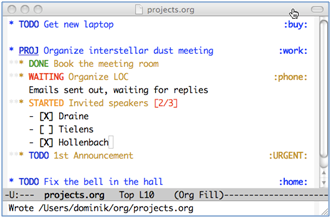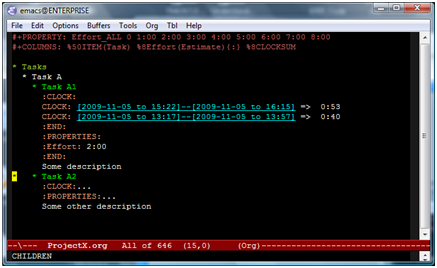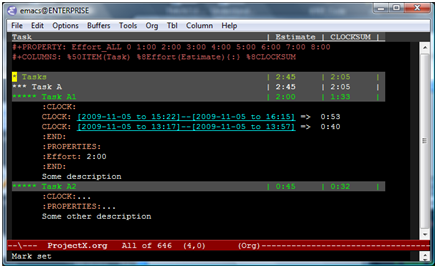It’s been four months and 350 clocked work-hours since I started using Org-mode for Emacs. I use Org-mode, mixed with some of the Pomodoro principles, to maintain my task lists at work and home.
Org-mode is a plug-in for Emacs that makes taking notes, maintaining lists, clocking time, and many other tasks more straightforward. The mode works by adding features on top of Emacs for editing plain text files. Features that enrich the interaction with the underlying text buffer by parsing and adding (meta-)information to it.
With Org-mode you group items into a hierarchical structure. A path to the item to work on is then formed by unfolding items in a way analogous to how you navigate the file system with Explorer.

To efficiently work with items, Org-mode supports moving items around the hierarchy. Items may also be tagged (buy, work, phone, etc.) or associated with a state (done, waiting, started, etc.). Additional meta-information may include a deadline, an estimate, or time spent working on a task. The clocking of time is accomplished by Org-mode adding a timestamp to the item. On completion, another timestamp and the elapsed time is calculated and added.
Below is an example of an expanded and a collapsed item containing clocked times and estimates.

With a few keystrokes, Org-mode is able to correlate estimates with time spent on an item-by-item basis. This truly short-circuits the estimation feedback cycle. Imagine doing this on a file containing a large hierarchy of items and the transparency it brings.

If you want to keep track of billable hours, it may make sense to clock all your time using Org-mode and generate timesheets from the clocking information. Especially since the billing context is automatically provided by the item storing the timestamp, and since you’re free to organize the file in any way you see fit. Few other tools manage to compete with the flexibility of a plain text buffer.
This post only scratches the surface of Org-mode. To get a sense of the possibilities, the manual amounts to 184 pages. However, for a quick introduction I encourage you to watch the Google Tech Talk on Org-mode.